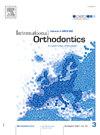Root symmetry between homologous upper incisors in non-orthodontic patients: A cross-sectional study
IF 1.9
Q2 DENTISTRY, ORAL SURGERY & MEDICINE
引用次数: 0
Abstract
Introduction
This study aimed to assess the symmetry in length, shape, and root dilaceration between homologous upper incisors of non-orthodontic patients using digital panoramic radiographs (DPR).
Methods
This retrospective cross-sectional study evaluated 200 DPR obtained from a private radiology centre in Lima, Peru. All successive patients meeting the eligibility criteria were included from January to August 2024 (86 men and 114 women, 27.84 ± 8.69 years and 28.52 ± 8.38 respectively). Eight hundred upper incisors were examined, divided equally into upper central incisors (UCI) (n = 400) and upper lateral incisors (ULI) (n = 400). The dental imaging software Blue Sky Plan 4.13.35 was utilized to evaluate root length (as a ratio), root shape (using the Albrecht classification), and root dilaceration (according to the Chohayeb classification) while comparing homologous upper incisors. For statistical analysis, weighted Kappa tests and binary logistic regression were employed, with the significance level set at P < 0.05.
Results
Among the 200 radiographs, root length symmetry was observed in 192 patients (96%) for UCI and in 185 patients (92.5%) for ULI. Additionally, root shape symmetry was found in 171 patients (85.5%) for UCI and in 124 patients (62%) for ULI. Regarding dilaceration symmetry, 198 patients (99%) showed symmetry for UCI, while 188 patients (94%) did so for ULI. The multivariate analysis indicated that the male sex was more likely to exhibit root shape symmetry in upper lateral incisors (P = 0.033).
Conclusions
Most homologous upper incisors display symmetry regarding root length, shape, and dilaceration. However, this symmetry is more prevalent in central than lateral incisors, in which the root shapes may differ between homologous teeth. Orthodontists should consider these findings in their practice.
非正畸患者同源上切牙根对称:一项横断面研究
本研究旨在利用数字全景x线片(DPR)评估非正畸患者同源上切牙长度、形状和根扩张的对称性。方法本回顾性横断面研究评估了秘鲁利马一家私人放射学中心获得的200例DPR。2024年1月至8月,所有符合入选标准的患者均入组,男性86例,女性114例,年龄分别为27.84±8.69岁和28.52±8.38岁。检查了800个上切牙,平均分为上中切牙(n = 400)和上侧切牙(n = 400)。利用牙科成像软件Blue Sky Plan 4.13.35,在比较同源上切牙的同时,评估牙根长度(作为比率)、牙根形状(使用Albrecht分类)和牙根扩张(根据Chohayeb分类)。统计分析采用加权Kappa检验和二元logistic回归,显著性水平设为P <;0.05.结果在200张x线片中,192例(96%)UCI患者和185例(92.5%)ULI患者观察到根长度对称。此外,171例UCI患者(85.5%)和124例ULI患者(62%)发现根形状对称。关于扩张对称性,198例(99%)患者表现为UCI对称,而188例(94%)患者表现为ULI对称。多因素分析结果显示,男性上侧切牙的牙根形状更对称(P = 0.033)。结论大多数同种上切牙在根长、根形和根扩张方面具有对称性。然而,这种对称在中门牙比侧门牙更普遍,在侧门牙中,根的形状可能在同源牙齿之间不同。正畸医生应该在实践中考虑这些发现。
本文章由计算机程序翻译,如有差异,请以英文原文为准。
求助全文
约1分钟内获得全文
求助全文
来源期刊

International Orthodontics
DENTISTRY, ORAL SURGERY & MEDICINE-
CiteScore
2.50
自引率
13.30%
发文量
71
审稿时长
26 days
期刊介绍:
Une revue de référence dans le domaine de orthodontie et des disciplines frontières Your reference in dentofacial orthopedics International Orthodontics adresse aux orthodontistes, aux dentistes, aux stomatologistes, aux chirurgiens maxillo-faciaux et aux plasticiens de la face, ainsi quà leurs assistant(e)s. International Orthodontics is addressed to orthodontists, dentists, stomatologists, maxillofacial surgeons and facial plastic surgeons, as well as their assistants.
 求助内容:
求助内容: 应助结果提醒方式:
应助结果提醒方式:


